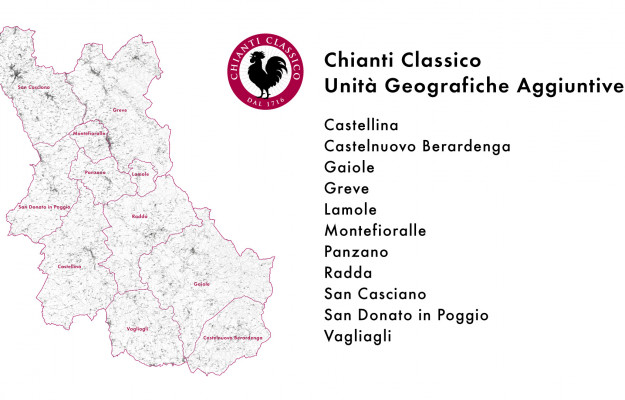Castellina, Castelnuovo Berardenga, Gaiole, Greve, Lamole, Montefioralle, Panzano, Radda, San Casciano, San Donato in Poggio (including the territories of Barberino Tavarnelle and Poggibonsi), Vagliagli- tThis is the list of the territories that will become Chianti Classico Additional Geographical References, approved by the a wide majority of the wine producers at the meeting of the Black Rooster Consortium, lead by Giiovanni Manetti.
The Consortium has taken a very important step to that will continue to enhance the territory( probably ne of the most beautiful wine territories in the world, situated between Renaissance Florence and Medieval Siena, ed.), which has been in the spotlight over the last several years. Further, the amendments made to the regulations of Gran Selezione, the top of Chianti Classico, where the minimum percentage of Sangiovese has increased from 80% to 90%, and the remaining 10% will consist of local red grapevines. The vote decided at the Assembly of the Consortium launched a new stage of “a project that we have presented following the Board of Directors’ many years of intense work demonstrating the need the Consortium had expressed to continue improving and enhancing the features that distinguish and make the Gallo Nero appellation unique”, the Consortium explained.
The first amendment proposed and approved at the Assembly of the members of the Consortium, concerned the project to subdivide the Chianti Classico production area into smaller and more uniform areas, to be able to indicate the name of the borgo or village on the label. Regarding PDO wines, National and European laws allow mentioning Additional Geographic References indicated within the denomination’s production zone. The objectives of the amendment proposed include strengthening the wine/territory communication, increasing quality in terms of identity and territory, letting consumers know the origin of the grapes and last but not least, stimulating demand through specialized offers. Putting the name of the village on the label will help to satisfy consumers’ interest who are more and more interested in knowing the relationship between the origins of Gallo Nero wines and the territory. This is the reason why several areas of the Chianti Classico production zone have been especially marked, based on specific criteria such as, wine recognition, history, reputation, and volumes produced.
The Consortium pointed out that during this first stage, the Added Geographical References will be applied only to the Gran Selezione typology, while they will be available for the other two typologies in the near future. This is a strategically important choice in order to strengthen the intentions of the UGA, which will represent the territories excellent products and be able to better compete with the great wines in the world. “The territory makes the difference, which has alwyas been one of our favorite mottos, confirmed Giovanni Manetti, president of the Consortium, “ and our territory is really unique, as two thirds is woodlands, while only one tenth is dedicated to wine growing and today 50 percent of the area is organically farmed (52.5% of the vineyards ). Our territory expresses all the typologies of Gallo Nero. Wine, as I have said many times over the last three years in my role as president of the Consortium, reflects the territory like the negative of a photograph, which is why it is so important to preserve the environment and landscape, tobe able to narrate all of the nuances to the consumer, even on the label.
The second proposed amendment to the regulations that the wine producers approved at the Assembly concerned the Chianti Classico Gran Selezione grape blends. Up until today, the three typologies of Chianti Classico- Vintage, Reserve and Gran Selezione – all had the same basic grape content, that is, 80-100% Sangiovese and up to maximum 20%of authorized local and/or International red grapevines. The new regulations, instead, provide that Gran Selezione typology minimum Sangiovese percentagewill increase to 90% and blends with other International grapes are no longer allowed, while the remaining, up to maximum 10%, can only be local red grapes .The link to the territory for this typology is fundamental, said the Consortium, as it is the only product that uses exclusively the Consortium grapes.
To strengthen the pair wine/territory and give major identification on the Chianti Classico Gran Selezione labels, the Assembly approved using exclusively local grapevines to complement Sangiovese, as they express and represent the production zone and the traditional Chianti viticulture better.The Chianti Classico Consortium pointed out that the Gran Selezione typology was introduced in the production regulations in 2013, while today 154 companies produce it for a total of 182 wines, representing 6% of the entire Chianti Classico wine production. Starting from the day it was put on the market, It has been very successful with the general public and has received excellent reviews from the press. Chianti Classsico has recently achieved its first 100/100, precisely with this typology, from one of the most influential International wine critics (James Suckling, awarded it to Chianti Classico Gran Selezione CeniPrimo 2018 by Barone Ricasoli-Castello di Brolio,ed.)
Copyright © 2000/2025
Contatti: info@winenews.it
Seguici anche su Twitter: @WineNewsIt
Seguici anche su Facebook: @winenewsit
Questo articolo è tratto dall'archivio di WineNews - Tutti i diritti riservati - Copyright © 2000/2025









































































































































































































